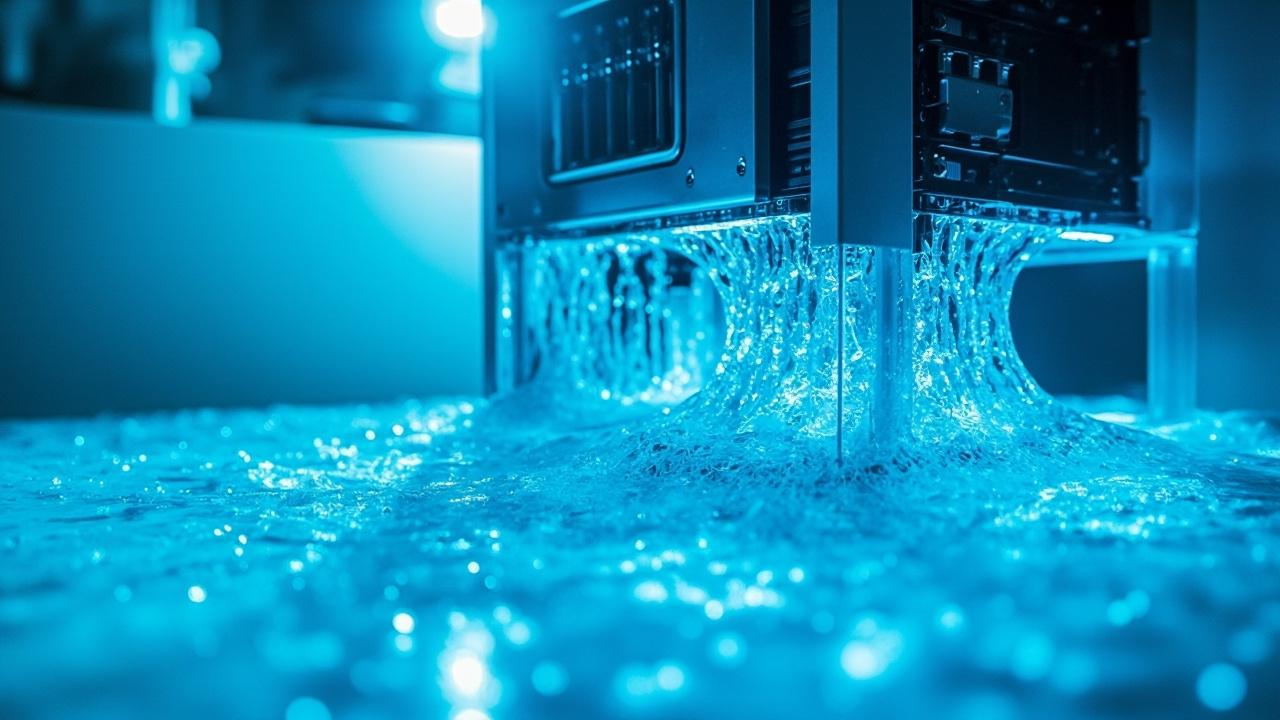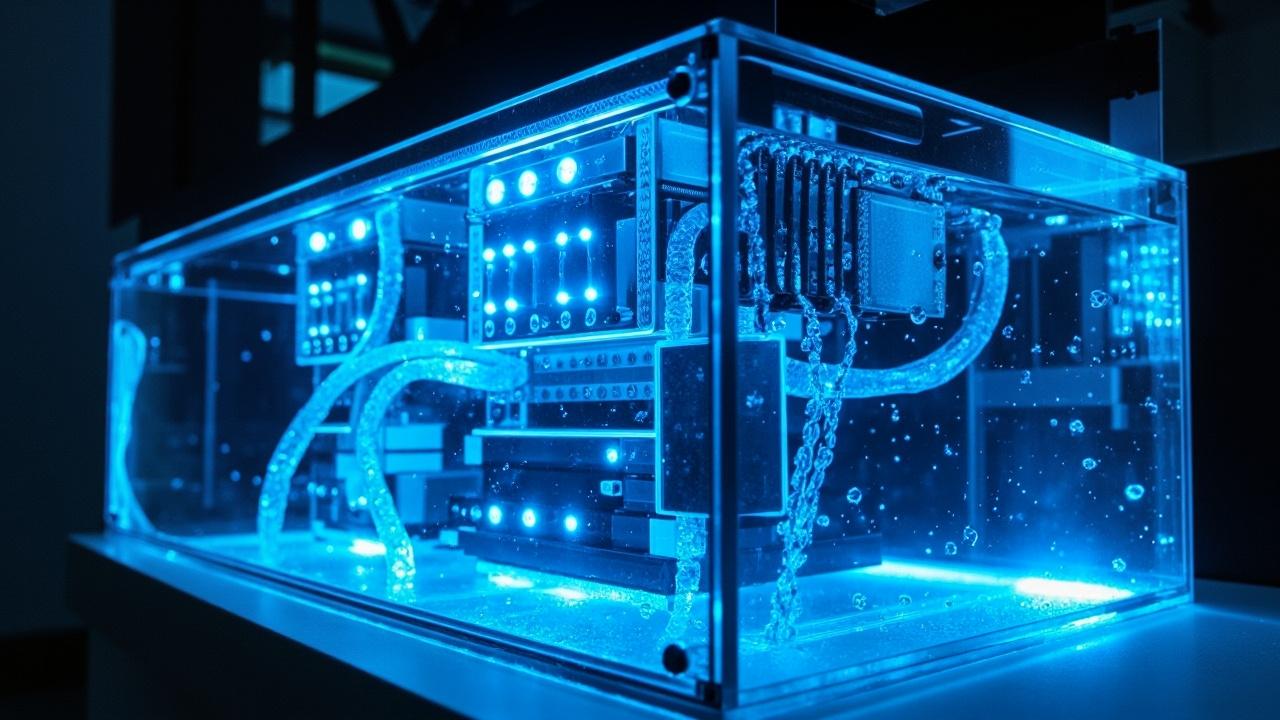Introduction
The rise of artificial intelligence is creating unprecedented computational demands, and with it, an escalating thermal challenge. AI liquid cooling is rapidly emerging as the only viable solution. The appetite of AI models for processing power is insatiable, demanding ever-greater performance from specialized hardware. This surge in power translates directly into heat, pushing the limits of traditional cooling methods.
An AI cluster, a network of high-performance computers working in concert to train and deploy AI models, is a prime example of this challenge. These clusters, packed with powerful GPUs, CPUs, and ASICs, generate immense amounts of heat within a confined space.
Traditional air cooling struggles to dissipate this heat effectively, leading to performance bottlenecks, reduced component lifespan, and increased energy consumption. The sheer density of modern AI hardware overwhelms conventional cooling systems, creating a thermal bottleneck that limits the potential of these powerful machines.
As AI workloads become more complex and power densities continue to rise, the limitations of air cooling become increasingly apparent. This blog post argues that liquid cooling is no longer a luxury but a necessity for maximizing performance, efficiency, and reliability in modern AI clusters. Embracing liquid cooling is a strategic move that unlocks the full potential of AI investments, ensuring that organizations can harness the power of AI without being held back by thermal constraints.
The Insatiable Thirst of AI
The relentless advancement of artificial intelligence hinges on its ability to process vast quantities of data at unprecedented speeds. This computational demand translates directly into an insatiable thirst for power within AI clusters. These clusters, essentially supercomputers dedicated to AI tasks, are composed of numerous high-performance servers packed with powerful processors – primarily GPUs, but also CPUs and specialized ASICs – all working in concert. Understanding the power density within these clusters is crucial to addressing the cooling challenges they present.
The architectural design of AI-optimized servers has shifted dramatically in recent years. Early AI deployments often relied on general-purpose servers adapted for GPU acceleration. However, the current trend is towards hyper-dense compute nodes specifically engineered to maximize the number of GPUs within a single rack unit.
This drive for density means squeezing more processing power into the same physical space, inevitably leading to a dramatic increase in heat generation. Training complex neural networks, for example, requires sustained peak performance from these processors, pushing their thermal design power (TDP) to its limits.
Consider this: a typical high-end GPU from just a few years ago might have had a TDP of around 250-300 watts. Today’s AI-focused GPUs routinely exceed 700 watts, and some specialized processors even approach 1000 watts per chip. When you multiply this by the number of GPUs in a single server, and then by the number of servers in a rack, the power density quickly becomes staggering.
It is due to these high power densities that methods, such as ai liquid cooling, have become more and more essential. Traditional air-cooling methods struggle to cope with these concentrated heat loads, leading to performance bottlenecks and potential hardware failures.
Air Cooling’s Breaking Point
Air cooling, the traditional method of dissipating heat in data centers, is rapidly approaching its limits when dealing with the intense thermal output of modern AI clusters. Simply put, the sheer volume of heat generated by densely packed GPUs, CPUs, and ASICs working on complex AI models is overwhelming the capacity of even the most aggressive air-cooled systems.
Trying to force more air across these components requires increasingly powerful fans, which in turn consume more energy and create an unbearable level of noise. The physics are straightforward: there’s a finite amount of heat that air can absorb and carry away, and we’re rapidly approaching that limit in high-density AI deployments.
The consequences of inadequate cooling extend far beyond just discomfort for data center staff. When chips overheat, they begin to throttle their performance, meaning they intentionally slow down to prevent damage. This directly translates to longer training times, slower inference speeds, and a significant reduction in the overall efficiency of the AI cluster.
Moreover, excessive heat accelerates the degradation of electronic components, leading to higher failure rates and shorter lifespans for expensive hardware. This translates into more frequent replacements, increased downtime, and a significant increase in operational costs. Data centers may also experience hotspots, localized areas of extreme heat that can create unstable conditions and potentially lead to catastrophic failures.
Furthermore, the escalating power demands of air cooling contribute to a vicious cycle. As more energy is consumed by fans, the overall energy consumption of the data center increases, driving up operating costs and putting a strain on the power grid.
This increased energy consumption also has significant environmental implications, contributing to higher carbon emissions and exacerbating the already considerable environmental footprint of AI development. In contrast, implementing ai liquid cooling offers a way to break free from these limitations and unlock the full potential of AI infrastructure while minimizing environmental impact.
| Issue | Impact of Insufficient Air Cooling |
|---|---|
| Performance Throttling | Reduced AI model training and inference speeds |
| Component Failure | Increased hardware replacement costs and downtime |
| Energy Consumption | Higher operating expenses and environmental impact |
| Noise Pollution | Disruptive work environment for data center staff |
Enter the Liquid Diet
Liquid cooling offers a significantly more efficient alternative by using a liquid, typically water or a specialized coolant, to absorb and dissipate heat. This method leverages the superior heat transfer properties of liquids compared to air. To illustrate, water has roughly 3,500 times the heat capacity of air, allowing it to absorb considerably more heat with a smaller temperature increase. This core advantage allows for much more effective heat removal from high-powered components.
Several liquid cooling approaches exist, each tailored to different needs and deployment scenarios. Direct-to-chip (D2C) cooling involves attaching cold plates directly to heat-generating components like CPUs and GPUs.
These cold plates contain channels through which the liquid coolant flows, drawing heat away from the chips and transferring it to a heat exchanger or cooling distribution unit (CDU). Another method is rear-door cooling, where a liquid-cooled heat exchanger is mounted on the rear door of the server rack.
This system captures the hot air exhausted from the servers and cools it before recirculating it back into the data center. Immersion cooling represents a more radical approach, fully submerging servers in a dielectric fluid that directly absorbs heat. Each of these systems requires careful planning and execution to prevent leaks and ensure maximum efficiency. The implementation of ai liquid cooling depends greatly on the system used.
- Direct-to-chip (D2C) Cooling
- Rear-door Cooling
- Immersion Cooling
By implementing liquid cooling, data centers can overcome the limitations of air cooling and unlock the full potential of their AI hardware. This translates into several benefits, including higher sustained performance, improved energy efficiency, and increased reliability. Liquid cooling allows chips to operate at higher clock speeds without throttling, enabling faster processing times and more accurate results.

It also reduces the energy required to cool the data center, lowering operating costs and reducing the environmental impact. Furthermore, by maintaining lower operating temperatures, liquid cooling extends the lifespan of critical components and minimizes the risk of downtime.
The Performance Boost
The advantages of adopting liquid cooling extend beyond mere temperature regulation; it’s a gateway to unlocking the untapped potential of your AI infrastructure. By maintaining optimal operating temperatures, liquid cooling eliminates thermal throttling, a common bottleneck that restricts the performance of air-cooled systems. Thermal throttling occurs when a processor or GPU overheats and reduces its clock speed to prevent damage.
This reduction in clock speed directly translates to slower processing times and reduced overall performance for AI workloads. With liquid cooling, components can consistently operate at their designed peak performance, leading to faster training times, quicker inference speeds, and improved accuracy in AI models. This is because the enhanced thermal management allows for sustained high-intensity operation without the performance penalties imposed by thermal constraints.
Consider the implications for AI training, a process known for its immense computational demands. A system equipped with ai liquid cooling can complete training cycles significantly faster than a comparable air-cooled system. This reduction in training time not only saves energy but also accelerates the development and deployment of AI models.
Moreover, the stable operating temperatures achieved through liquid cooling contribute to greater consistency and predictability in AI performance. This reliability is crucial for applications where real-time decision-making is critical, such as autonomous vehicles or financial trading platforms. The ability to maintain peak performance without thermal limitations also allows for the adoption of more aggressive overclocking strategies, further boosting the computational capabilities of the hardware.
To illustrate the performance gains, consider a case study involving a large language model (LLM) training on a cluster of GPUs. An air-cooled system might experience a 15-20% performance drop due to thermal throttling during prolonged training sessions. In contrast, a liquid-cooled system can maintain consistent peak performance throughout the entire training process.
This difference translates to a significant reduction in training time, potentially saving days or even weeks on a single training run. Furthermore, the ability to run at higher clock speeds and maintain stable temperatures enables the use of cutting-edge AI hardware that would otherwise be thermally constrained in an air-cooled environment. This allows organizations to leverage the latest advancements in AI technology and stay ahead of the curve.
| Metric | Air Cooling | Liquid Cooling |
|---|---|---|
| Performance Drop (Thermal Throttling) | 15-20% | 0% (negligible) |
| Training Time (LLM) | Significantly Longer | Significantly Shorter |
| Clock Speed Stability | Unstable, fluctuating | Stable, consistent |
Efficiency and Sustainability
Liquid cooling offers compelling advantages in terms of energy efficiency and environmental responsibility for AI clusters. Unlike traditional air-cooled systems that expend significant energy on fans and chillers to dissipate heat, liquid cooling’s superior thermal conductivity allows for more targeted and efficient heat removal.
This translates directly into lower power consumption and reduced operational costs for data centers. Furthermore, forward-thinking data centers are exploring innovative ways to recapture the heat generated by AI clusters using liquid cooling systems, turning what was once a waste product into a valuable resource.
Reduced Energy Consumption and Lower OPEX
One of the most significant benefits of *ai liquid cooling* is its potential to drastically reduce energy consumption. Air cooling systems require substantial power to operate fans and chillers, often accounting for a large portion of a data center’s energy bill. Liquid cooling, with its higher thermal conductivity, can achieve the same level of cooling with significantly less energy.
Studies have shown that liquid cooling can reduce energy consumption by as much as 30-50% compared to air cooling, leading to substantial savings in operating expenses (OPEX) over the lifespan of the AI cluster. The reduced load on cooling infrastructure also translates to a smaller data center footprint, freeing up valuable space and resources.
Heat Recovery and Reuse
Beyond reducing energy consumption, liquid cooling opens up possibilities for heat recovery and reuse. The heat absorbed by the cooling liquid can be captured and used for other purposes, such as heating buildings, powering absorption chillers, or even generating electricity. This not only reduces the data center’s carbon footprint but also creates new revenue streams.
Implementing a heat recovery system requires careful planning and infrastructure investment, but the long-term benefits in terms of sustainability and cost savings can be substantial. This approach aligns perfectly with the growing emphasis on circular economy principles in the data center industry.
Addressing Water Usage Concerns
While liquid cooling offers many environmental benefits, it’s important to address concerns about water usage. Some liquid cooling systems rely on evaporative cooling, which can consume significant amounts of water. However, closed-loop liquid cooling systems minimize water consumption by recirculating the cooling liquid and using dry coolers or other technologies to reject heat to the environment without evaporation.
These systems significantly reduce or even eliminate water usage, making them a more sustainable option for data centers in water-stressed regions. Ultimately, responsible water management is paramount, and selecting the appropriate cooling technology is crucial for minimizing environmental impact.
Demystifying AI Liquid Cooling Implementation
Many data center managers and IT professionals considering liquid cooling solutions for their AI clusters often harbor concerns regarding complexity, initial investment, and ongoing maintenance. These anxieties, while understandable, are often rooted in misconceptions about the current state of liquid cooling technology. In reality, liquid cooling has advanced significantly and is now more accessible, reliable, and manageable than ever before. Let’s address some of the key areas of concern.
Complexity and Management
One of the biggest perceived hurdles is the complexity of implementing and managing liquid cooling systems. Some worry about leaks, specialized training requirements, and the integration of new infrastructure into existing data centers. Modern liquid cooling solutions, however, are designed with ease of use in mind.
Closed-loop systems, for example, minimize the risk of leaks, while prefabricated and modular designs simplify installation. Furthermore, many vendors offer comprehensive training and support programs to equip IT staff with the necessary skills to manage these systems effectively. Modern software solutions also enable the proactive management of the systems, allowing IT staff to monitor and manage them remotely.

Cost Considerations
The initial investment in liquid cooling is another common concern. While the upfront cost may be higher than air cooling, it’s important to consider the total cost of ownership (TCO). Liquid cooling can lead to significant long-term savings through reduced energy consumption, improved hardware lifespan, and increased rack density.
These benefits can quickly offset the initial investment, making liquid cooling a more cost-effective solution in the long run. Furthermore, governments and utility companies are providing more incentives and rebates to data centers that use efficient cooling technologies such as ai liquid cooling.
Real-World Success Stories
Numerous organizations have successfully deployed liquid cooling in their AI clusters, demonstrating its viability and effectiveness. For example, many high-performance computing (HPC) centers have long relied on liquid cooling to manage the extreme heat generated by their powerful systems.
These deployments serve as proof points that liquid cooling can be implemented and managed successfully in real-world environments. As more companies embrace liquid cooling, best practices and case studies are becoming increasingly available, providing valuable insights for those considering this technology.
Beyond the Server Room
AI’s relentless pursuit of more processing power isn’t just changing server room dynamics; it’s poised to reshape the landscape of computation itself. While traditionally confined to data centers, the ability to deploy AI is now expanding to edge computing environments and even mobile applications.
This paradigm shift is, in no small part, fueled by the advancements in thermal management, specifically, the innovative solutions of ai liquid cooling. The need to efficiently cool high-powered AI hardware in these diverse locations necessitates thinking outside the confines of traditional air-cooled server rooms.
Consider the implications for edge computing. Imagine AI-powered analytics being performed on-site at a manufacturing plant, analyzing sensor data in real-time to optimize production processes. Or autonomous vehicles making split-second decisions based on environmental data. These applications require significant computational resources located close to the source of data.
Air cooling might be impractical or impossible in these scenarios due to space constraints, environmental factors, or power limitations. *AI liquid cooling* offers a viable solution, enabling the deployment of high-performance AI hardware in these challenging environments. The uses for this technology can be further illustrated in the following examples:
Looking ahead, liquid cooling’s influence extends far beyond enabling new applications. It’s fundamentally altering how we design data centers and develop AI hardware. As chip densities continue to increase, the ability to efficiently remove heat will become a primary design constraint.
This necessitates closer collaboration between chip manufacturers, cooling system vendors, and data center architects to co-design solutions that optimize both performance and thermal management. This collaborative approach will likely lead to the development of new chip architectures optimized for liquid cooling and innovative data center designs that integrate liquid cooling infrastructure from the ground up. All of this will certainly have a positive downstream impact on the total cost of ownership.
Conclusion
The demands of modern AI are undeniable, and as we’ve explored, the traditional methods of managing the resulting heat are quickly becoming obsolete. Ignoring the thermal challenges inherent in these high-density environments is no longer a viable option.
It’s clear that maximizing performance, ensuring reliability, and promoting sustainability within your AI infrastructure requires a paradigm shift. By now, it should be abundantly clear: ignoring the inevitable shift to advanced cooling methodologies is a strategic misstep that will impact efficiency and future growth.
The transition to liquid cooling, especially *ai liquid cooling*, represents more than just a technological upgrade; it’s a strategic investment in the future of AI. By embracing this cooling technology, organizations are not only equipping themselves to handle today’s demanding workloads but are also positioning themselves to capitalize on future advancements in AI hardware and software.
This forward-thinking approach unlocks the full potential of cutting-edge processors, facilitates unparalleled computational power, and allows companies to push the boundaries of AI innovation.
We urge you to carefully consider the benefits of liquid cooling as you plan your next AI cluster deployment. Research the available solutions, consult with experts, and explore the possibilities that liquid cooling can unlock.
The future of AI is being built on a foundation of efficiency, performance, and sustainability, and liquid cooling is the key to laying that foundation successfully. The potential gains in performance and the reduced operational costs make a compelling case for taking the plunge into liquid cooling solutions for your AI infrastructure.
Frequently Asked Questions
What is AI liquid cooling and how does it differ from traditional liquid cooling?
AI liquid cooling uses intelligent systems to optimize the liquid cooling process, dynamically adjusting flow rates and temperatures based on real-time data. Traditional liquid cooling relies on static settings, whereas AI-powered systems leverage sensors, machine learning, and sophisticated algorithms to ensure optimal cooling performance based on the specific workload and environmental conditions.
This allows for greater efficiency and responsiveness.
Why is AI liquid cooling becoming more important for data centers and AI workloads?
AI liquid cooling is gaining importance due to the increasing power density and heat generated by modern AI workloads in data centers. Traditional air cooling struggles to effectively dissipate the heat from high-powered processors and GPUs.
The concentrated heat from AI chips demands a more efficient and targeted cooling approach, and AI liquid cooling addresses this challenge by directly and precisely cooling the heat sources.
What are the different types of AI liquid cooling solutions available (e.g., direct-to-chip, immersion cooling)?
AI liquid cooling solutions come in various forms. Direct-to-chip cooling involves attaching cold plates directly to processors or GPUs, circulating coolant through them. Immersion cooling submerses entire servers in a dielectric fluid, directly absorbing heat from all components. Hybrid approaches are also emerging, combining direct-to-chip with other cooling methods, all optimized through AI-driven management.
What are the benefits of using AI liquid cooling, such as improved performance, energy efficiency, and density?
Using AI liquid cooling yields numerous benefits. It enables improved performance by allowing processors to operate at higher clock speeds without overheating. The technology increases energy efficiency by precisely targeting cooling efforts where they are needed most. Also, it facilitates higher density server deployments, as more powerful hardware can be packed into a smaller space thanks to efficient heat removal.
What are the challenges and considerations when implementing AI liquid cooling in a data center environment?
Implementing AI liquid cooling presents challenges. It requires careful planning and infrastructure modifications, including specialized cooling distribution units and leak detection systems. The dielectric fluids need special handling and disposal considerations. Furthermore, the initial investment in AI-powered liquid cooling systems can be significant and require careful return on investment calculations.




